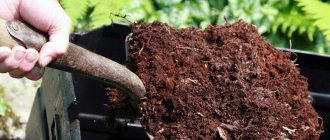Home » Flowers and plants » Outdoor plants » ? Roses
Olga Polyakova 03.23.2020
1196 Views
The most beautiful flowers are generally recognized to be roses - this is a domesticated variety of a wild plant called rose hips. Combining beauty, a huge variety of shades, an abundance of flowers on the plant and a wonderful aroma, roses are truly considered the “queens of gardens.” Naturally, every queen requires royal care, and roses are no exception to this rule.
What is different about autumn rose care?
Spring and summer care for roses is aimed at active growth and development of plants. Autumn care, on the contrary, involves slowing down their vegetation. Why is this necessary? Roses change their state somewhat in autumn:
- Lignification of the stems occurs;
- Shoots and buds slow down development;
- The root accumulates nutrition and strengthens;
- All metabolic processes slow down.
This is how nature prepares rose bushes for frost. How to properly care for roses in the autumn? Let's figure it out.
Features of autumn fertilizing and watering
Watering in the fall should be reduced, and from the end of September should be stopped altogether. This way we will stop the activity of roses and start the natural process of preparing the bushes for winter dormancy. If autumn is rainy, then the rose garden needs to be protected from excess moisture. To do this, stretch a film over the bushes and make grooves around the flower bed to drain water.
In the fall, you need to radically change the composition of fertilizers for roses. Nitrogen fertilizers are used only during the active growing season; they stimulate the growth of stems and leaves. We don't need this now. Strengthening the root is the main goal of autumn feeding of rose bushes. For this, our roses need potassium, phosphorus and magnesium. You can use granular fertilizers that are scattered onto the surface of loose soil under rose bushes.
What to feed roses in the fall?
Fertilizing can be carried out in three ways: dry fertilizer composition poured under the root; liquid fertilizer for irrigation; liquid fertilizer for spraying the above-ground part of the bush.
I. Fertilizer for irrigation
A tablespoon of potassium sulfate, 2 tablespoons of phosphate and half a teaspoon of boric acid are added to a bucket of water. You can water roses with this solution 2 times in the fall - at the beginning and end of September, and in cold regions - at the end of August and beginning of September.
II. Spray composition
For 30 liters of water you need to take a tablespoon of potassium monophosphate and superphosphate. The bush should be irrigated with this solution every 3-4 weeks until mid-October.
III. Dry feeding
There are two folk remedies that gardeners use today for flowers and garden crops in the fall. These are wood ash (sources of phosphorus and potassium) and grated banana peel. The ash is diluted in water or sprinkled with dry powder on the ground. Banana peels are crushed dry and dug into the soil under the roses. You can bury fresh banana peels under the roots, but this should only be done in early autumn so that the fertilizer has time to rot.
Such products can be combined, but the main thing to remember is that the last feeding should be done no later than the beginning of October (or mid-September in cold climates). The last means of nutrition, and at the same time disinfection, is potassium magnesia in granules. It can be scattered over the surface of the soil before covering the roses in October or November.
How to carry out preventive measures in the fall?
Autumn is a period of active reproduction of pathogenic bacteria and rot. Pests look for wintering sites, which often turn out to be the stems and leaves of roses. Flowers are especially vulnerable during this period, since all their strength has already been devoted to growth and flowering, so they need the following preventive measures:
- Regularly clean the soil around the bushes.
It is necessary to remove weeds, fallen leaves and other debris, since all this, when rotting, can infect the roots and trunk of plants; - Trimming lower leaves and shoots.
The lower leaves and shoots are the first to be affected by diseases, so they must be completely removed from mid-September (at least 30 cm from the root); - Treatment.
After cleaning and removing the leaves, the rose stems are treated with fungicides or a disinfecting solution of manganese and soda. You can buy a ready-made disinfectant composition for autumn treatment in a specialized store.
How to prune roses for the winter?
From the beginning of September it is necessary to control the abundance of rose blooms. All bud buds should be bent at the base. This way they will not develop. If you cut them, you can provoke the growth of new buds and shoots:
Pruning roses for the winter is a mandatory autumn event for all varieties. But each variety requires a special approach. So, for climbing roses, pruning may consist of pinching out the growing points, while bush and species varieties need to be pruned thoroughly.
Roses are pruned 1-2 weeks before covering. From the beginning of September, it is necessary to cut off all affected stems, unfallen leaves, young shoots and buds. In front of the shelter itself, 3-5 strong stems are left, cutting off the top to woody areas.
Trimming
To work with rose bushes, it is recommended to choose a clear day without wind or rain.
- Flower growers living in cold climates (Siberia, the Urals, St. Petersburg) prune roses in the second ten days of October.
- In central Russia, such work can begin at the end of October.
- In the southern regions, for example, in Kuban, this event can be postponed until early November.
It is very important to prune roses at air temperatures from -2 ْ to -4 ْС, not higher. The fact is that pruning itself pushes the plant to begin development. Young buds may begin to grow on the eve of frost, which will lead to disease or death of the bush. After pruning, the bushes need to be properly insulated to create good conditions in winter.
Correctly carried out procedures will provide the plant with increased frost resistance. Pruning old branches will give impetus to the development of young shoots in the spring. In addition, the buds will be larger.
It is necessary to treat not only adult plants, but also young bushes of the first year of life. This procedure should be carried out for all plants annually in the fall. But, there are types of roses that do not require pruning.
Pruning rules
There are some rules for pruning roses in the fall. These should be followed to get a high-quality plant with many buds:
- The shoots are cut at an angle of 45 degrees.
- Dry, diseased, pest-damaged shoots are removed.
- All unripe shoots are also removed.
- For work, you should use only a sharp and clean knife so as not to injure the plant.
Important! Immediately after pruning, the cut sites are treated with wood ash or any antiseptic. This will help reduce the risk of infection by harmful microorganisms.
Pruning for different types of roses
Depending on the type of rose, its size and intensity of development, you can choose the type of pruning in the autumn:
- Short (strong) pruning - the length of the branches is about 5-10 cm. They are practically cut off completely, leaving only 2-3 buds near the ground on each shoot.
- Medium (moderate) - the length of the branches is about 30-40 cm. When pruning the shoots, 5 buds are left from the ground. Dry and diseased branches are removed. With the arrival of spring warmth, the rose produces a lot of young shoots.
- Long (light) - branches 70-100 cm. Here, pruning is carried out only at the tips of the branches, on which at least 10 buds should remain.
Watch the video! How to prune roses for the winter and cover them
Features of pruning different types of roses
- In climbing rose , for example, in the Rambler variety, which bloom with small flowers, only the tips of the branches are cut off. Climbing types of roses with large flowers remove all faded stems, but leave 2-3 shoots from last season. The side shoots are cut off, leaving 10 cm, which should have 2-3 buds.
- The polyanthus type of roses is famous for its enhanced growth and lush flowering. Old and immature branches of the plant are cut off, and all the rest are shortened, leaving 3-4 buds on each. In polyanthus roses with small flowers, 2-3 buds are left when trimming strong shoots, and on weak shoots - up to 1-2 buds. This treatment promotes better development of the bush and active flowering.
- Hybrid tea roses do not require heavy pruning, as this may result in the development of new shoots without flowers. Therefore, when pruning, stems up to 30 cm in length with 5 buds are preserved. However, this type of pruning also does not lead to massive flowering of the bush.
Advice! If flowers appear on the top of the branches, but the lower part of the bush does not bloom, then you need to cut off all the old shoots and trim the rest short.
- Medium pruning in autumn is also carried out for such types of roses as grandiflora and remontant ones.
- The Pernetian rose variety is in many ways similar to the hybrid tea variety. In one and the other plant, flowers are formed at the ends of the shoots of one year of life. Therefore, in the autumn, they trim a third of the growth. Dry and damaged parts of the plant are cut off completely.
- Before planting, all branches of cascading standard roses are cut short to 15 cm from the ground. The next year and with each subsequent year, the old branches are cut shorter and shorter. The young shoots are left, slightly shortened.
- Floribunda roses have the ability to quickly grow to large sizes. For such branched plants, combined treatment of the bush is used. Half of the stems are cut short, the other half is shortened medium. The remaining side shoots are cut off, leaving only 2-3 buds on the shoot.
- Park roses undergo light pruning, leaving about 8-10 young buds on the stems. The same method is used for pruning rose varieties such as Bengal, English, and hybrid tea roses with large flowers. For Old English species and bush roses, the stems are cut back by two-thirds.
- Climbing roses , which can be divided into those that bloom once and repeatedly, require a special approach to such a procedure as pruning. So, the first ones form buds on last year’s branches. In autumn they are cut off, leaving young shoots. The latter produce buds on the main stems for three seasons, and in the fourth year, for the winter period . At the same time, be sure to leave 4-6 strong and healthy stems that are still capable of blooming.
Ground cover rose varieties are not pruned in the autumn. In order to sanitize the bushes, it is enough to remove old, damaged and dry branches. It is recommended to cut off all branches once every few years, leaving stumps up to 15 cm from the ground.
Transplanting rose bushes
September-early October is the best time to replant roses. The first in line to change their place of residence should be weak roses that have responded poorly to care throughout the entire growth period. For new residents of your rose garden, it is also better to find suitable places in the fall:
The process of transplanting roses is as follows:
- Choosing a sunny, open place for flowers;
- Marking and preparing holes for planting. Miniature roses can be planted thicker (40-50 cm between bushes), climbing and bush varieties require sparse plantings - 1-1.5 meters. The standard size of the holes is 50x50 cm;
- Preparation of nutrient soil mixture. Peat, sand and compost are taken in equal proportions. The soil for roses can be diluted with clay. Ash, bone meal and other nutritional components are added to the finished mixture;
- Planting seedlings. Pre-soaked seedlings are lowered into the holes with their roots, the roots need to be straightened. The bush is covered with earth and watered thoroughly. When the water is absorbed, the young roses need to be spudded.
Preparing for shelter
Each trimmed bush must be treated with a fungicide, diluted garden paint or iron sulfate and hilled to a height of 30 cm. Now the roses are ready for shelter in the winter. The type of shelter is selected depending on the variety of rose and the climatic conditions of the region. This can be covering material, spruce branches, dry foliage or specially constructed structures.
Cover the roses
For winter covering of roses, thick spunbond (non-woven, agrotex) is best suited. The width of the covering material must be at least 0.5 m. The wider, the better.
Instead of spunbond, spruce spruce branches are perfect.
Everything is covered on top with additional material that does not allow water to pass through. It can be roofing felt, thick cardboard, etc. Film is undesirable because it is easily torn off by the wind, and the edges cannot be fixed to the ground: there must be air circulation during the thaw so that the plants do not dry out.
Many experienced rose growers use lutrasil to cover roses - they stretch it over the roses onto a frame.
You cannot sprinkle fallen leaves on roses, as they will rot and rot and will most likely infect the bushes with rot. Leaves can only be used on top of shelters.
Caring for roses in September
At this stage, you must adhere to the following rules:
- We stop trimming roses for bouquets, as this stimulates the growth of new buds. For young roses that you did not allow to bloom in the summer, you need to leave the last inflorescences and let them ripen;
- Reduce watering. If September is hot and dry, you can water your roses once a week until the middle of the month. After watering, we do it once every 2 weeks and completely stop watering the rose garden by the end of September;
- We replace growth-stimulating nitrogen fertilizers with potassium-phosphorus fertilizers. This way we will strengthen the root, and the plant will better survive the cold. We often don’t feed roses; two feedings are enough.
Your actions this month:
I. Feeding the roots with a potassium phosphate composition
You can scatter dry granules near the roots and lightly compact them into the soil, or you can prepare a liquid solution (see tips above) for watering or spraying the green part of the roses.
II. Last loosening of the soil
It is better to do it immediately after feeding the bushes. This may allow the last rosebuds to ripen faster.
III. Limited watering
Ideally, roses should be watered twice in September - at the beginning and towards the end of the month. If September is not dry, then there is no need to water the rose garden additionally.
IV. Weeding
All young weeds should be removed from the rose garden. They can become a source of infections.
V. Removing the lower foliage of roses
Leaves are also often affected by infections; moreover, their presence can stimulate photosynthesis and prevent the rose from slowing down metabolic processes. All leaves up to a height of 20-30 cm must be removed.
VI. Stem processing
After removing the foliage, bare stems should be painted with garden varnish, water-based solution or other disinfectants. This will protect the bushes from rot and pests that are looking for a place for the winter in the stems of plants.
Events at the end of the warm season
Autumn pruning of roses
It is necessary to begin the autumn preparation of roses for wintering with fairly simple, but nevertheless very important events.
First of all, they concern the preparation of the soil in the rose garden for further work, which will be carried out directly with the roses.
The soil in the rose garden should be perfectly clean by the end of September:
- there should be no weeds, leaf debris or broken branches on it
- it should be weeded and loosened to a depth of 5-7 cm
- it must be treated against ground pests
All these events should be carried out in the second ten days of September.
During weeding, you should remove not only weeds, but also annual plants planted under bushes and in row spaces.
This weeding will be the last of the season. After this, no manipulations with the soil of the rose garden should be carried out (except for those that accompany the shelter), so as not to further disturb the root system of the plants.
Caring for the rose garden in October
The features of this stage are as follows:
- We stop loosening the soil under the roses to slow down the access of oxygen to the roots;
- Stop watering roses and fertilizing them;
- If October is rainy, then the rose garden needs to be covered with film and water should be drained from the roots;
- At this stage, disease prevention is mandatory - spraying and cleaning the bushes.
You need to follow these steps:
- Spraying bushes with 1% Bordeaux mixture. This will rid the stems of bacteria and pests;
- Tear off all the foliage and bend the unripe buds. There is no need to trim the buds yet; this may trigger the release of new inflorescences, especially if October is warm;
- We trim the roses. Shrub, miniature and heat-loving roses should be shortened to the height of insulation. Climbing and standard varieties need to be pinched at the growth point, removed from the support and laid on the ground;
- We replant roses that did not grow well this season, or plant new varieties for the rose garden.
Fungus treatment
October is the most suitable month for taking preventive measures against various diseases and pests. In order to avoid the spread of spores, pruned shoots (including damaged ones) and fallen leaves must be collected and burned. The soil should be dug up; this action will provoke freezing of the fungus.
Spraying is also an effective method. Experienced flower growers know that parasites can adapt to even the lowest temperatures, and therefore flowers need protection. To prevent diseases, a 1%-3% solution of Bordeaux mixture is suitable. It is also recommended to spray the bushes and the soil around them with a solution of copper sulfate (3 - 5%).
November works in the rose garden
The last and shortest stage of caring for roses is the beginning of November. During this period, fertilizing, watering, processing and any activities that may stimulate sap flow inside the plants are not carried out.
A week of consistently negative temperatures outside should be a signal to cover roses for the winter, which consists of the following steps:
- Removing garbage, digging up the ground and hilling rose bushes to a height of 30 cm. If the roses were laid on the ground for the winter, then a hill 50 cm high is poured onto the root;
- Construction of a shelter for roses for the winter. This can be a bulk method, an air shelter, a frame method, etc. Read more about ways to cover roses for the winter in our other materials.
So, you can breathe easy. Autumn has come to an end. Your roses are securely covered and properly prepared to survive the winter successfully. Now all that remains is to wait for spring, anticipating the grateful blooming of the pets in your rose garden.
Covering standard and climbing roses
Shelter of a standard rose
Tall plants - standard and climbing roses - have certain characteristics in their pre-winter wrapping. The former may have grafts located high from the ground, the latter may generally have too long shoots, which, moreover, are located on special trellises or various structures.
For standard roses, the trunk, crown, and also the grafting site are wrapped. The optimal material for this is coconut mats; You can also use other insulation materials:
- burlap
- agrofibre
- straw
- etc.
If the trunk is still young and has not too lignified shoots, it is recommended to bend it to the ground and cover it at ground level. It is even recommended to hill up the entire bush, that is, completely cover it with soil.
Climbing roses are treated similarly, with the only difference being that it is not recommended to completely cover them with soil. They are removed from the supports, the necessary trimming is carried out and laid on the ground, where they are covered using any of the previously described methods.











